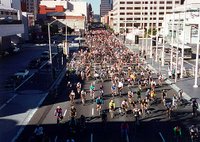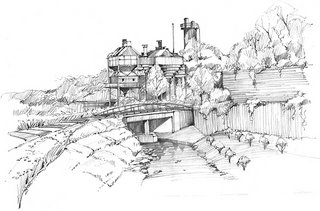this is a story about a boy and his milk
and the bike that made it all possible on his day off
- - -
So an ATL buddy came into town this week en route to the World Cup in Germany. The plan was to bike around the region today. As the bike rental place is across town, we decided to try fitting one of us on the back of my bike bracket as many of the locals do.
Whhrrrrmppp. Needless to say, we the bike was tacoed in the first turn. Bummer. The
Pink Pony is down. See the evidence:

I tried to straighten it out, but the result was a little too jenky. So now we needed two bikes to rent. No problem. A couple of euros later we hit the well maintained, numerous bike paths that weave through every city here. (note: I did not say “hit the streets with the car traffic”) Within 15 minutes we were out of the downtown and among the windmills and farmland, biking for about 3 hours from town to town.

At 1pm on the way back in, this dairy in the next town over opened for the day, so I visited it for the first time. Where I live is a city of 90,000 people. It is not a farm town. There are cities of 400,000 people and 600,000 people both 8 miles from our downtown. The density and planning are so remarkable though, that choose any direction and within a few minutes you will be in woods or fields with no traffic and fresh air.
The dairy was awesome. There was this huge faucet coming out of this mysterious wall that added to our bounty: one liter of unpasteurized whole milk, one liter of unpasteurized buttermilk, a 300g hunk of aged gouda cheese, some homemade butter, and some homemade yogurt. There was a line out the door when we left. In twenty-five minutes the goods were back in my refrigerator.

Ate lunch at home. Got some fresh baked bread and a smoked herring from the
tri-weekly farmer’s market in the city, and washed them down with a frothy cold glass of milk. The milk was unbelievable. Like nothing I have ever tasted.

Set out for the late afternoon to evening ride. The next town over in the opposite direction has a series of houses with these crazy lawns. I wanted to both run through them and give this guy a trophy:

A couple of little towns later, hit the southern-most part of the trip. In this city of 15,000 they had all these roads blocked off for a jogging race - with spectators. And it was a Thursday.

Then biked 20km or so to the beach, weaving through cow pastures and greenhouses. Got to see the ferries arrive from England and got a little sunburned while lounging.

Two towns way from home at 9pm. Saw this church that was crazy slanted which must have been sinking as they built it. I’m not tilting my camera for this photo.

One town from home. Some locals were getting seated to their neighborhood pubs. One guy painted the outside of his entire bar in red, white, and blue stripes from roof to sidewalk. Another guy wrapped his whole building in orange.

Returned the bike at 10:25pm. Watched the sunset between the spires of the cathedrals. Didn’t stay long though, as there were
live performances on stages throughout the city at this time. The
festival is called “mooi weer spelen” which translates into “beautiful weather on stage” – sort of a summer-is-here-now-so-we-can-hang-outside event. 11:30pm on a Thursday. I see hundreds and hundreds of people walking about. Unreal.
I just don’t understand how they get all these people from all over the country to travel here for these bi-monthly multi-day festivals. Especially since nearby cities do their own events as well. From a tented jazz festival and mardi gras celebration (with floats) during one month to a theatre festival and party-on-the-canals celebration during another month. It can make your head explode.
today’s events have taught me a few things:- small cities can flourish, and explode with creativity and amenities, when both willing organizers and an interested public step up to make things happen
- connectivity of urban transit and population density is entirely related to quality of life issues and happiness for a good chunk of a region’s inhabitants
- biking around 70 or 80 kilometers in one day makes your butt hurt
- a glass of really cold milk, fresh from a cow, makes it feel better
























